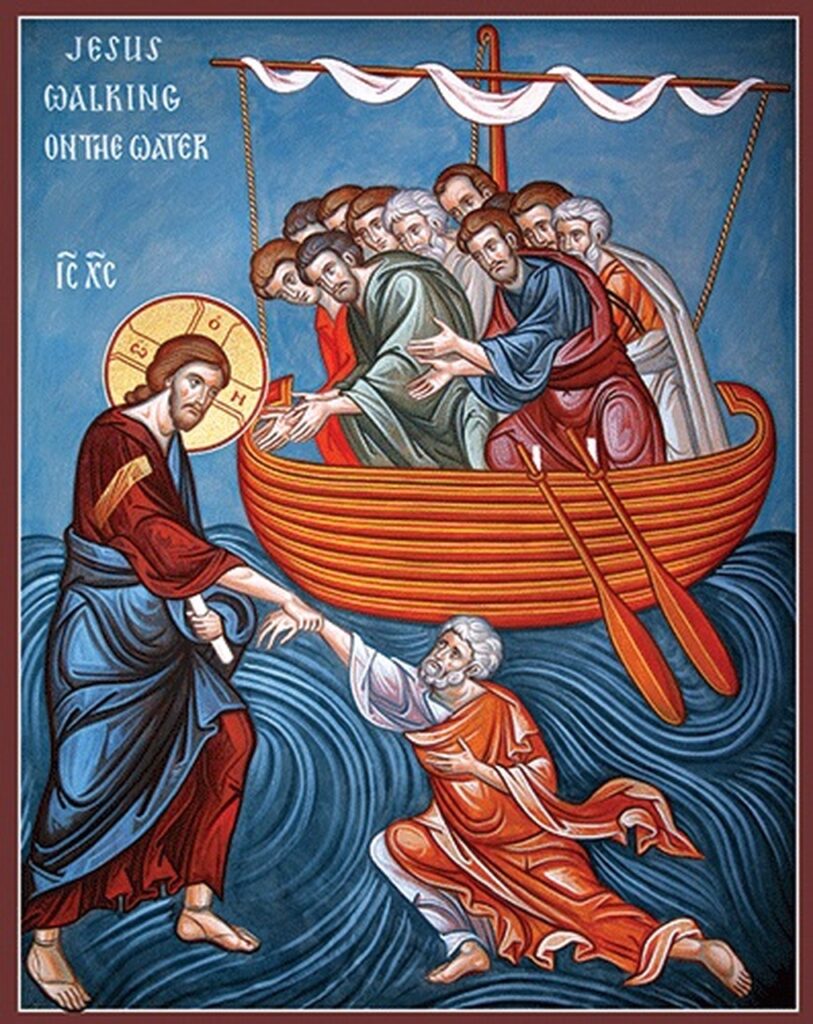The episod of John 6:16-21 takes place immediately after the multiplication of the loaves. The disciples, without Jesus, go down to the lake of Tiberias. The wind is strong, the night falls, and the crossing becomes perilous. In the midst of the turbulent sea, Jesus appears walking upon the waters and utters Ego eimi – “It is I.” The Koine Greek adds no complement: it does not say “It is I, Jesus,” but simply Ego eimi, the same theophanic formula used by God in Exodus – “I Am that I Am.”
In Hebrew, waters is מים (Maim). These are the lower waters, fluid and unstable, a representation of multiplicity. The Sea of Tiberias is Malkuth in motion, the manifested world. It is also the psychic matrix, the plane of emotions and forms. When the disciples cross the sea without the Master, they are within the Maim without the Shem, matter without the Name.
The appearance of Christ upon the waters is the descent of the Name upon substance. The Logos walks upon the Maim; that is, He imposes order upon chaos. The Hebrew tradition contains a direct echo of this in Genesis: “And the Spirit of God moved upon the face of the waters” (רוּחַ אֱלֹהִים מְרַחֶפֶת עַל־פְּנֵי הַמָּיִם). The same movement is repeated here, but now incarnate. The Word walks.

When Christ says Ego eimi, He pronounces in Koine Greek the equivalent of Ehyeh Asher Ehyeh (אהיה אשר אהיה) revealed to Moses. This Name belongs to the sefirah Kether, the summit where Being is pure identity. “I Am” is the Name that points nowhere, since it is Being recognising itself.
The episode of John 6:16–21 may also be read as the solar operation upon the lunar world. The sea, which is humid, reflective, subject to wind and tide, is the very Luna Mundi, the psyche. The waters move according to the influence of the Moon, a perfect image of the human soul, which only reflects the light of the Spirit and never produces it.
When Christ (Sun, Logos, Spirit) appears walking upon the waters, what manifests is the re-established celestial hierarchy: the solar principle governing the lunar. The Sun suffers no phases; it neither waxes nor wanes; it simply is, it simply radiates. Thus Ego eimi is a solar act, a pure enunciation of Being, without shadow or reflection.
The Moon, sigil of the unconscious and emotion, is ordered. It receives from the Sun, and paradoxically during her realm of nighttime, the precise measure of light. Just as the sea grows calm under the rising Sun, the psychic world is harmonised when the Word rises within it.
The Logos is Tifereth, the solar heart of the Tree; the sea is Yesod, the lunar foundation. When Tifereth governs Yesod, the reflection ceases to distort the image. The crossing ends, as reflection and source become a single radiance. But the crossing finds its true completion in Malkhut – the Kingdome – where the Divine radiance finally takes form.
The entire episode may thus be seen as an operation of the Middle Pillar (עמוד האמצעי, Amud ha-Emtsa’i), the column of equilibrium through which the Light of Kether descends and condenses in Tifereth, the Son. From there it harmonises the lunar psyche (Yesod) and guides humanity towards Malkhut, the realm of manifestation, now illumined by the Light of the Spirit even in the nighttime where shadows grow larger.
Not only that, but Christ walking upon the waters reveals this descent made flesh. To walk is an act of the feet – רגלים (Raglayim), from the root רגל (regel), meaning “to step,” “to traverse,” or “to spy out a path.” In Hebrew, Raglayim has the numerical value 283, the same as גפר (Gopher), the wood from which Noah’s Ark was built. The parallel is luminous: the feet and the wood are instruments of passage, vessels that bear life above the waters.
In Him, even the Raglayim bear the Light; they tread upon the surface where the veil divides Being from non-being. The divine Fire touches the waters without sinking. The same number 283 seals both mysteries: the feet of Adam Kadmon, where the supernal Light meets the world below, and the gopher wood that upheld Noah upon the flood. In Christ, these two symbols converge, as matter becomes the living vessel of the Spirit.
Also, when Christ says “Be not afraid”, we behold a subtle operation of Tikkun Yesod, the restoration of the lunar foundation. Fear is precisely the symptom of a Moon plunged in shadow, the psychic mirror clouded by its own varying tides. It is the trembling of Yesod when it loses alignment.
In that instant, the Word performs an inner rectification. “Μὴ φοβεῖσθε” (Mē phobeisthe) – “Be not afraid”, a creative act, restoring cosmic order. The vibration of the Logos penetrates the watery sphere and stills its chaos. The Moon is called back to her proper orbit beneath the Sun. Fear dissolves when the lower light remembers its source.
Κύριε ελέησον
